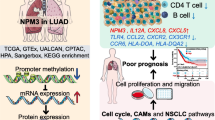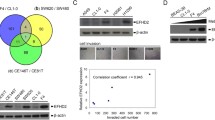Abstract
Background
CDH3 is a glycoprotein with a single-span transmembrane domain that mediates cell-to-cell adhesion. Abnormal expression of CDH3 is associated with a poor prognosis in patients with breast, thyroid, colorectal carcinomas and glioblastoma. Soluble CDH3 in pleural effusions can be used as a marker for real-time monitoring of resistance to first- and second-generation EGFR-TKIs. The CDH3 mechanism underlying lung adenocarcinomas (LUADs) has not been established.
Objective
This study analyzed the correlation between CDH3 expression and lung cancer prognosis and the effect of down-regulation CDH3 expression on the proliferation and migration of lung cancer cells.
Methods
CDH3 expression was studied using the Oncomine, TIMER, PanglaoDB, and GEPIA databases. The effect of CDH3 on clinical prognosis was assessed with GEPIA, the PrognoScan database, and Kaplan–Meier plotter. The relationship between CDH3 to immune infiltrating cells was explored using TIMER and TISIDB. The function of CDH3 in lung cancer cell lines was determined by CCK-8 and wound healing assays in vitro. Furthermore, RNA sequencing was used to identify key signaling pathways and differentially-expressed genes.
Results
LUAD tissues had higher CDH3 expression compared with normal tissues and were associated with worse overall survival in patients with LUAD. CDH3 expression had positive associations with infiltration of CD4 + T cells, Tregs and exhausted T cells, but negative associations with infiltration of B cells in patients with LUAD. CCK-8 and wound healing assays revealed that downregulation of CDH3 inhibited the proliferation and migration of cells. KEGG analysis revealed that the TGF-beta signaling pathways were demonstrated to be enriched pathways for genes negatively regulated by knockdown of CDH3.
Conclusion
CDH3 expression affects proliferation and migration of lung cancer cells and might serve as a potential prognostic marker in LUAD patients.









Similar content being viewed by others
References
Barbee MS, Ogunniyi A, Horvat TZ, Dang TO (2015) Current status and future directions of the immune checkpoint inhibitors ipilimumab, pembrolizumab, and nivolumab in oncology. Ann Pharmacother 49(8):907–937
Le Borgne-Rochet M, Angevin L, Bazellieres E, Ordas L, Comunale F, Denisov EV et al (2019) P-cadherin-induced decorin secretion is required for collagen fiber alignment and directional collective cell migration. J Cell Sci 132(21):233189
Bruno TC (2020) New predictors for immunotherapy responses sharpen our view of the tumour microenvironment. Nature 577(7791):474–476
Cavallaro U, Christofori G (2004) Cell adhesion and signalling by cadherins and Ig-CAMs in cancer. Nat Rev Cancer 4(2):118–132
Domvri K, Zarogoulidis P, Darwiche K, Browning RF, Li Q, Turner JF et al (2013) Molecular targeted drugs and biomarkers in NSCLC, the evolving role of individualized therapy. J Cancer 4(9):736–754
Facciabene A, Motz GT, Coukos G (2012) T-regulatory cells: key players in tumor immune escape and angiogenesis. Can Res 72(9):2162–2171
Ferreira C, Lobo J, Antunes L, Lopes P, Jeronimo C, Henrique R (2018) Differential expression of E-cadherin and P-cadherin in pT3 prostate cancer: correlation with clinical and pathological features. Virchows Arch 473(4):443–452
Franzen O, Gan LM, Bjorkegren JLM (2019) PanglaoDB: a web server for exploration of mouse and human single-cell RNA sequencing data. Database (oxford). https://doi.org/10.1093/database/baz046
Gao J, Aksoy BA, Dogrusoz U, Dresdner G, Gross B, Sumer SO et al (2013) Integrative analysis of complex cancer genomics and clinical profiles using the cBioPortal. Sci Signal. 6(269):pl1
Germain C, Gnjatic S, Tamzalit F, Knockaert S, Remark R, Goc J et al (2014) Presence of B cells in tertiary lymphoid structures is associated with a protective immunity in patients with lung cancer. Am J Respir Crit Care Med 189(7):832–844
He K, Lv W, Zheng D, Cheng F, Zhou T, Ye S et al (2015) The stromal genome heterogeneity between breast and prostate tumors revealed by a comparative transcriptomic analysis. Oncotarget 6(11):8687–8697
Herbst RS, Heymach JV, Lippman SM (2008) Lung cancer. N Engl J Med 359(13):1367–1380
Hsiao TF, Wang CL, Wu YC, Feng HP, Chiu YC, Lin HY et al (2020) Integrative omics analysis reveals soluble cadherin-3 as a survival predictor and an early monitoring marker of EGFR tyrosine kinase inhibitor therapy in lung cancer. Clin Cancer Res 26:3220–3229
Hsu KH, Ho CC, Hsia TC, Tseng JS, Su KY, Wu MF et al (2015) Identification of five driver gene mutations in patients with treatment-Naive lung adenocarcinoma in Taiwan. PLoS ONE 10(3):e0120852
Kwiatkowski DJ, Harpole DH Jr, Godleski J, Herndon JE 2nd, Shieh DB, Richards W et al (1998) Molecular pathologic substaging in 244 stage I non-small-cell lung cancer patients: clinical implications. J Clin Oncol 16(7):2468–2477
Li T, Fan J, Wang B, Traugh N, Chen Q, Liu JS et al (2017) TIMER: a web server for comprehensive analysis of tumor-infiltrating immune cells. Can Res 77(21):e108–e110
Li F, Wan B, Li XQ (2022) Expression profile and prognostic values of CDH family members in lung adenocarcinoma. Dis Markers 2022:9644466
Liu P, Weng Y, Sui Z, Wu Y, Meng X, Wu M et al (2016) Quantitative secretomic analysis of pancreatic cancer cells in serum-containing conditioned medium. Sci Rep 6:37606
Mizuno H, Kitada K, Nakai K, Sarai A (2009) PrognoScan: a new database for meta-analysis of the prognostic value of genes. BMC Med Genomics 2:18
Ohtani H (2007) Focus on TILs: prognostic significance of tumor infiltrating lymphocytes in human colorectal cancer. Cancer Immun 7:4
Pan JH, Zhou H, Cooper L, Huang JL, Zhu SB, Zhao XX et al (2019) LAYN is a prognostic biomarker and correlated with immune infiltrates in gastric and colon cancers. Front Immunol 10:6
Paredes J, Albergaria A, Oliveira JT, Jeronimo C, Milanezi F, Schmitt FC (2005) P-cadherin overexpression is an indicator of clinical outcome in invasive breast carcinomas and is associated with CDH3 promoter hypomethylation. Clin Cancer Res 11(16):5869–5877
Paredes J, Correia AL, Ribeiro AS, Albergaria A, Milanezi F, Schmitt FC (2007) P-cadherin expression in breast cancer: a review. Breast Cancer Res 9(5):214
Peralta Soler A, Knudsen KA, Salazar H, Han AC, Keshgegian AA (1999) P-cadherin expression in breast carcinoma indicates poor survival. Cancer-Am Cancer Soc 86(7):1263–1272
Perou CM, Sorlie T, Eisen MB, van de Rijn M, Jeffrey SS, Rees CA et al (2000) Molecular portraits of human breast tumours. Nature 406(6797):747–752
Peyssonnaux C, Eychene A (2001) The Raf/MEK/ERK pathway: new concepts of activation. Biol Cell 93(1–2):53–62
Rhodes DR, Kalyana-Sundaram S, Mahavisno V, Varambally R, Yu J, Briggs BB et al (2007) Oncomine 3.0: genes, pathways, and networks in a collection of 18,000 cancer gene expression profiles. Neoplasia 9(2):166–180
Rodenhuis S, van de Wetering ML, Mooi WJ, Evers SG, van Zandwijk N, Bos JL (1987) Mutational activation of the K-ras oncogene. A possible pathogenetic factor in adenocarcinoma of the lung. N Engl J Med 317(15):929–935
Ru B, Wong CN, Tong Y, Zhong JY, Zhong SSW, Wu WC et al (2019) TISIDB: an integrated repository portal for tumor-immune system interactions. Bioinformatics 35(20):4200–4202
Seo JS, Ju YS, Lee WC, Shin JY, Lee JK, Bleazard T et al (2012) The transcriptional landscape and mutational profile of lung adenocarcinoma. Genome Res 22(11):2109–2119
Sheng Q, D’Alessio JA, Menezes DL, Karim C, Tang Y, Tam A et al (2021) PCA062, a P-cadherin targeting antibody-drug conjugate, displays potent antitumor activity against P-cadherin-expressing Malignancies. Mol Cancer Ther 20(7):1270–1282
Sigel K, Makinson A, Thaler J (2017) Lung cancer in persons with HIV. Curr Opin HIV AIDS 12(1):31–38
Soda M, Choi YL, Enomoto M, Takada S, Yamashita Y, Ishikawa S et al (2007) Identification of the transforming EML4-ALK fusion gene in non-small-cell lung cancer. Nature 448(7153):561–566
Takeuchi K, Soda M, Togashi Y, Suzuki R, Sakata S, Hatano S et al (2012) RET, ROS1 and ALK fusions in lung cancer. Nat Med 18(3):378–381
Tang Z, Li C, Kang B, Gao G, Li C, Zhang Z (2017) GEPIA: a web server for cancer and normal gene expression profiling and interactive analyses. Nucleic Acids Res 45(W1):W98–W102
Taniuchi K, Nakagawa H, Hosokawa M, Nakamura T, Eguchi H, Ohigashi H et al (2005) Overexpressed P-cadherin/CDH3 promotes motility of pancreatic cancer cells by interacting with p120ctn and activating rho-family GTPases. Can Res 65(8):3092–3099
Torre LA, Bray F, Siegel RL, Ferlay J, Lortet-Tieulent J, Jemal A (2015) Global cancer statistics, 2012. CA Cancer J Clin 65(2):87–108
Waniczek D, Lorenc Z, Snietura M, Wesecki M, Kopec A, Muc-Wierzgon M (2017) Tumor-associated macrophages and regulatory T cells infiltration and the clinical outcome in colorectal cancer. Arch Immunol Ther Exp (warsz) 65(5):445–454
Yokota J, Nishioka M, Tani M, Kohno T (2003) Genetic alterations responsible for metastatic phenotypes of lung cancer cells. Clin Exp Metastasis 20(3):189–193
Yoshioka H, Yamamoto S, Hanaoka H, Iida Y, Paudyal P, Higuchi T et al (2012) In vivo therapeutic effect of CDH3/P-cadherin-targeting radioimmunotherapy. Cancer Immunol Immunotherapy CII 61(8):1211–1220
Zhang H, Liu H, Shen Z, Lin C, Wang X, Qin J et al (2018) Tumor-infiltrating neutrophils is prognostic and predictive for postoperative adjuvant chemotherapy benefit in patients with gastric cancer. Ann Surg 267(2):311–318
Zhao ZR, Lau RWH, Long H, Mok TSK, Chen GG, Underwood MJ et al (2018) Novel method for rapid identification of micropapillary or solid components in early-stage lung adenocarcinoma. J Thorac Cardiovasc Surg 156(6):2310–2318
Acknowledgements
We would like to thank Nan Ding from Beijing Cancer Hospital for helpful suggestions. We also would like to express their gratitude to EditSprings (https://www.editsprings.cn) for the expert linguistic services provided.
Funding
This study was supported by the National Natural Science Foundation of China (no. 82103289).
Author information
Authors and Affiliations
Contributions
WM designed the research and wrote the manuscript. JH reviewed the manuscript.
Corresponding author
Ethics declarations
Conflict of interest
The authors declare that the research was conducted in the absence of any commercial or financial relationships that could be construed as a potential conflict of interest.
Additional information
Publisher's Note
Springer Nature remains neutral with regard to jurisdictional claims in published maps and institutional affiliations.
Supplementary Information
Below is the link to the electronic supplementary material.
Rights and permissions
Springer Nature or its licensor (e.g. a society or other partner) holds exclusive rights to this article under a publishing agreement with the author(s) or other rightsholder(s); author self-archiving of the accepted manuscript version of this article is solely governed by the terms of such publishing agreement and applicable law.
About this article
Cite this article
Ma, W., Hu, J. Downregulated CDH3 is correlated with a better prognosis for LUAD and decreases proliferation and migration of lung cancer cells. Genes Genom (2023). https://doi.org/10.1007/s13258-023-01476-5
Received:
Accepted:
Published:
DOI: https://doi.org/10.1007/s13258-023-01476-5




